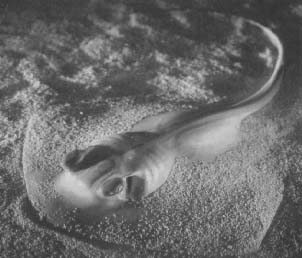Stingrays

Bluntnose Stingray digging into sand
photo by Fritz Goro, Living Fishes o the World, p.
58
If a venomous ray stings your arm or leg, you will
probably live, but if your abdomen is injured by a venomous ray,
your chances of surviving are not as good. In one case, a 12-year-old
Mexican boy who was loading shrimp was stung in his abdomen by
a stingray. He died in less than 2 hours. The venom from a ray
causes your heart to stop beating or to beat irregularly. It also
affects your breathing and central nervous system.
What You Should Do
Never walk barefoot in a sandy or muddy area where
rays are likely to occur. Don't dive headfirst into water in such
areas. If you are skin diving, don't swim in a prone (lying-down)
position close to the bottom. If you are injured by a ray you
should get expert medical help as quickly as possible. In the
meantime:
1. Rinse the wound thoroughly with fresh water.
Use ocean water only if no fresh water is available.
2. Cover the wound in water that is as hot as you
can tolerate but not so hot that it burns your skin (about 110
degrees Fahrenheit or 44 degrees Celsius). This should ease the
pain within about 30 to 90 minutes. You can repeat this if the
pain comes back.
3. Carefully search for and remove any pieces of
the stinger or its sheath (protective covering). Scrub the injured
area with soap and water. Then pour lots of fresh water over it.
4. Do not tape or sew the wound closed unless this
is needed to stop a lot of bleeding.
5. If the wound shows signs of infection, you will
need to take antibiotics. You may also need a tetanus shot.

